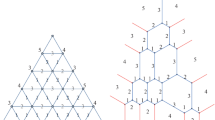Abstract
We prove that mean multiplicities in the length spectrum of a non-compact arithmetic hyperbolic orbifold of dimension \(n \geqslant 4\) have exponential growth rate
extending the analogous result for even dimensions of Belolipetsky, Lalín, Murillo and Thompson. Our proof is based on the study of (square-rootable) Salem numbers. As a counterpart, we also prove an asymptotic formula for the distribution of square-rootable Salem numbers by adapting the argument of Götze and Gusakova. It shows that one can not obtain a better estimate on mean multiplicities using our approach.
Similar content being viewed by others
Data availability
There is no data related to this work.
Notes
Formally, a closed geodesic is a pair \(([\gamma ], L)\), where \([\gamma ]\) is the equivalence class of \(\gamma \) up to shifts of argument, and L is its period. In other words, a closed geodesic “remembers” its length and orientation, but not its starting point.
An isometry u of \({{\,\mathrm{\mathbb {H}}\,}}^n\) is called an elliptic transformation if its action on \({{\,\mathrm{\mathbb {H}}\,}}^n\) has a fixed point. When u lies in a discrete subgroup of \({{\,\textrm{Isom}\,}}({{\,\mathrm{\mathbb {H}}\,}}^n)\), it is elliptic if and only if it has finite order.
References
Anosov, D.V.: On generic properties of closed geodesics. Mathematics of the USSR-Izvestiya 21(1), 1 (1983)
Belolipetsky, Mikhail, Lalín, Matilde, Murillo, Plinio G. P., Thompson, Lola: Counting Salem numbers of arithmetic hyperbolic 3-orbifolds. Bull. Braz. Math. Soc. (N.S.), 53(2):553–569, (2022)
Bogomolny, E.B., Georgeot, B., Giannoni, M.-J., Schmit, C.: Chaotic billiards generated by arithmetic groups. Phys. Rev. Lett. 69(10), 1477–1480 (1992)
Bogomolny, E.B., Schmit, C.: Multiplicities of periodic orbit lengths for non-arithmetic models. J. Phys. A 37(16), 4501–4526 (2004)
Bolte, J.: Periodic orbits in arithmetical chaos on hyperbolic surfaces. Nonlinearity 6(6), 935–951 (1993)
Emery, V., Ratcliffe, J.G., Tschantz, S.T.: Salem numbers and arithmetic hyperbolic groups. Trans. Amer. Math. Soc. 372(1), 329–355 (2019)
Gangolli, R., Warner, G.: Zeta functions of Selberg’s type for some noncompact quotients of symmetric spaces of rank one. Nagoya Math. J. 78, 1–44 (1980)
Götze, F., Gusakova, A.: On the distribution of Salem numbers. J. Number Theory 216, 192–215 (2020)
Hirschhorn, M.: 87.67 Sums Involving Square-Free Integers. Math. Gaz. 87, 527–528 (2003)
Kronecker, L.: Zwei Sätze über Gleichungen mit ganzzahligen Coefficienten. J. Reine Angew. Math. 53, 173–175 (1857)
Li, J.-S., Millson, J.J.: On the first Betti number of a hyperbolic manifold with an arithmetic fundamental group. Duke Math. J. 71(2), 365–401 (1993)
Margulis, G.A.: Certain applications of ergodic theory to the investigation of manifolds of negative curvature. Funkcional. Anal. i Priložen. 3(4), 89–90 (1969)
Marklof, J.: On multiplicities in length spectra of arithmetic hyperbolic three-orbifolds. Nonlinearity 9(2), 517–536 (1996)
Masters, J.D.: Length multiplicities of hyperbolic 3-manifolds. Israel J. Math. 119, 9–28 (2000)
OEIS Foundation Inc. The On-Line Encyclopedia of Integer Sequences, . Published electronically at http://oeis.org (2023)
Randol, B.: The length spectrum of a Riemann surface is always of unbounded multiplicity. Proc. Amer. Math. Soc. 78(3), 455–456 (1980)
Ratcliffe, John G.: Foundations of hyperbolic manifolds, volume 149 of Grad. Texts Math. Cham: Springer, 3rd expanded edition edition, (2019)
Scott, J.: 90.15 Square-Freedom Revisited. Math. Gaz. 90, 112–113 (2006)
Smyth, C.: Seventy years of Salem numbers. Bull. Lond. Math. Soc. 47(3), 379–395 (2015)
Widmer, M.: Counting primitive points of bounded height. Trans. Amer. Math. Soc. 362(9), 4793–4829 (2010)
Acknowledgements
I am grateful to my advisor Mikhail Belolipetsky for bringing my attention to this problem and helpful comments that have significantly improved this note. I am also thankful to the anonymous referees for their careful reading and valuable suggestions. This study was financed in part by the Coordenação de Aperfeiçoamento de Pessoal de Nível Superior, Brasil (CAPES).
Author information
Authors and Affiliations
Corresponding author
Additional information
Publisher's Note
Springer Nature remains neutral with regard to jurisdictional claims in published maps and institutional affiliations.
About this article
Cite this article
Grebennikov, A. Multiplicities in the Length Spectrum and Growth Rate of Salem Numbers. Bull Braz Math Soc, New Series 55, 25 (2024). https://doi.org/10.1007/s00574-024-00398-4
Received:
Accepted:
Published:
DOI: https://doi.org/10.1007/s00574-024-00398-4



